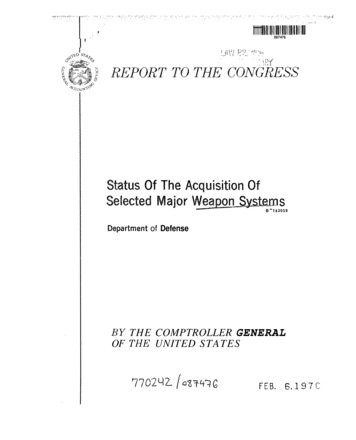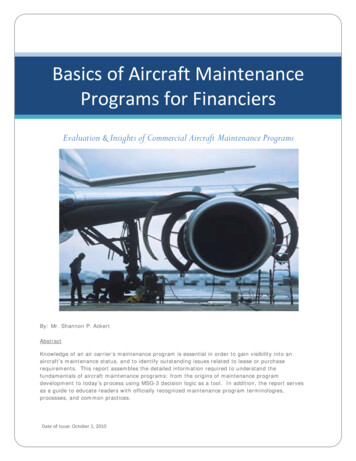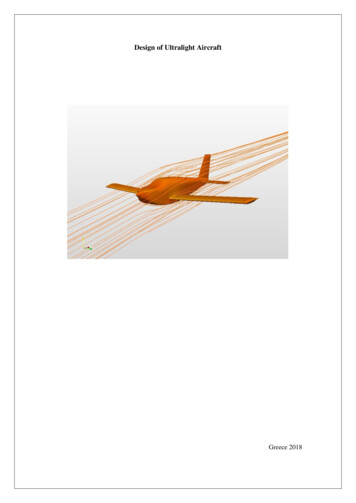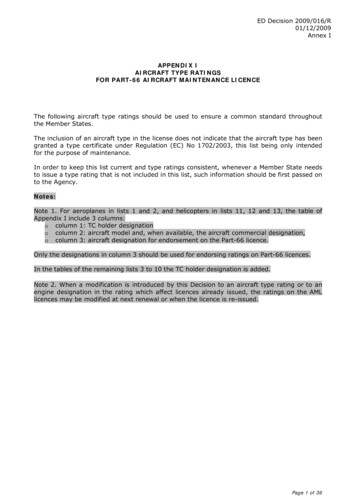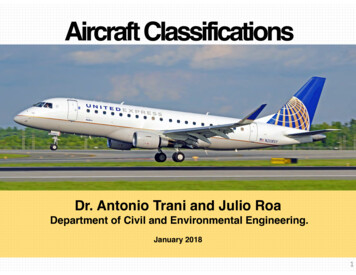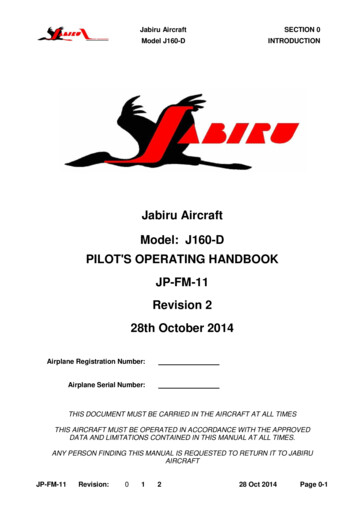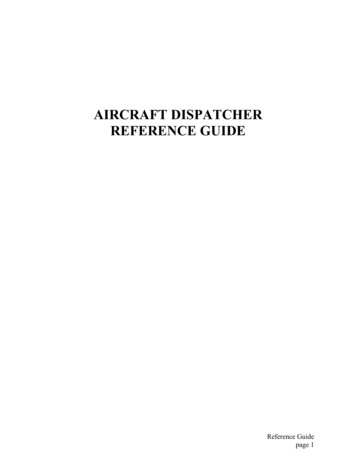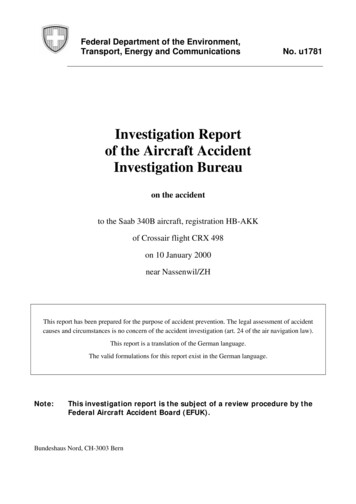
Transcription
Federal Department of the Environment,Transport, Energy and CommunicationsNo. u1781Investigation Reportof the Aircraft AccidentInvestigation Bureauon the accidentto the Saab 340B aircraft, registration HB-AKKof Crossair flight CRX 498on 10 January 2000near Nassenwil/ZHThis report has been prepared for the purpose of accident prevention. The legal assessment of accidentcauses and circumstances is no concern of the accident investigation (art. 24 of the air navigation law).This report is a translation of the German language.The valid formulations for this report exist in the German language.Note:This investigation report is the subject of a review procedure by theFederal Aircraft Accident Board (EFUK).Bundeshaus Nord, CH-3003 Bern
Investigation Report CRX 498Ve 18.11.03AcknowledgementsThe Aircraft Accident Investigation Bureau (AAIB) thanks the following representatives ofauthorities and organizations for the support given to it in the course of the investigation:Aeroflot Russian Airlines, RussiaAirport police of ZurichBureau Enquête Accidents de FranceCantonal police of ZurichCEFA Aviation FranceChipworks Ltd.Civil Aviation Academy, St. Petersburg, RussiaCrossair AGEMPA - Federal Materials Testing and Research InstituteFederal Office for Civil AviationFederal Office of Communications (OFCOM)Fire-fighting department of the airport of Zurich-Kloten and the municipality of Nassenwil,NiederhasliFlightscape Inc.Flughafen Zurich AGHoneywell Aerospace ElectronicsInstitute for Forensic Medicine of Zurich UniversityInstitute for Geodesy and Photogrammetry of the ETH ZurichInterstate Aviation Committee, RussiaInstitute of aviation medicine of the Swiss Air ForceMeteo Schweiz AGMoldavian AirlinesMoldavian Civil Aviation AuthorityNational Transportation Safety Board, USARockwell-Collins Inc.RUAG AerospaceRussian Civil Aviation AuthoritySaab Aircraft ABScandinavian Airlines System (SAS) Flight AcademyScientific Department of the Zurich city policeSeismology Department of the ETH ZurichSextant AvionicsSlovakian Civil Aviation AuthoritySpecial Duties Section of the Federal Department for the Environment, Transport, Energy andCommunications (DETEC – Umwelt, Verkehr, Energie und Kommunikation – UVEK)SR Technics Ltd.Swissair Ltd.Swisscom AGSwisscontrol AGTechnical Department of the News sub-group of the Federal Department for Defense, CivilProtection and Sport (Verteidigung, Bevölkerungsschutz und Sport – VBS)Transportation Safety Board of CanadaUljanovsk Aviation School, RussiaUniversal Avionics Inc.Aircraft Accident Investigation Bureaupage 2/118
Investigation Report CRX 498Ve 18.11.03Synopsis 9Brief presentation 9Investigation 91Factual information 111.1 Prior history and history of the flight 111.1.1 Prior history for the last 24 hours1.1.1.1The aircraft1.1.1.2Flight crew1.1.2 History of the flight111111111.2 Injuries to persons 141.3 Damage to the aircraft 141.4 Other damage 141.5 Personnel information 141.5.1 Commander1.5.2 First officer1.5.3 Cabin attendant1.5.4 Air traffic controller (TWR)1.5.5 Air traffic controller (DEP)1.5.6 Training, examinations and certification1.5.6.1Pilot training in the former Soviet Union at the Krementschug flying school1.5.6.2Training of the crew of flight CRX 4981.5.6.2.1 Commander1.5.6.2.2 First officer141516161617171818201.6 Aircraft information 231.6.1 Aircraft HB-AKK1.6.1.1General1.6.1.2Left engine1.6.1.3Right engine1.6.1.4Left propeller1.6.1.5Right .2 Mass and centre of gravity1.6.3 Flight controls1.6.3.1Control and control forces1.6.3.1.1 Background information1.6.3.1.2 Findings on the aircraft involved in the accident1.6.3.2Flap system1.6.3.3Control blockage1.6.3.4Gust lock warning1.6.3.5Disconnect handle1.6.4 Engines and propellers1.6.4.1Left-hand engine1.6.4.2Right-hand engine1.6.4.3Propellers1.6.4.4Summary1.6.5 Cockpit configuration1.6.5.1General1.6.6 Flight guidance systems1.6.6.1Electronic flight instrument system (EFIS)1.6.6.1.1 Electronic instrument displays1.6.6.1.2 Description of the system1.6.6.1.3 EFIS failure after switching on the logo lightsAircraft Accident Investigation 29293030303031page 3/118
Investigation Report CRX 498Ve 18.11.031.6.6.2Automatic flight system (AFS)1.6.6.2.1 Description of the system1.6.6.2.2 Presentation of the flight director1.6.6.2.3 Investigation of the mode select panel1.6.6.2.4 Use of the automatic flight system1.6.6.3Flight management system (FMS)1.6.6.3.1 Description of the system1.6.6.3.2 Installation1.6.6.3.3 Certification1.6.6.3.4 Training1.6.6.3.5 Operating experience1.6.6.3.6 Maintenance1.6.6.3.7 Navigation database1.6.6.3.8 Misleading navigation1.6.6.3.9 Use of the FMS1.6.6.4Other navigation equipment1.6.6.4.1 VOR displays1.6.6.4.2 Air data system1.6.7 Bank angle warning system1.6.8 Ground proximity warning system1.6.9 Performance of the aircraft1.6.10Maintenance of the aircraft1.6.10.1 Maintenance records1.6.10.2 Procedures in the metalwork shop1.6.11Examination of the fuel 43431.7 Meteorological information 441.7.1 General weather situation1.7.2 Weather at Zurich airport1.7.3 Weather in the region of the accident1.7.4 Pilots' .4.4Precipitation1.7.4.5Temperature on the ground1.7.4.6Observations on icing1.7.5 Icing1.7.5.1Air temperature1.7.5.2Atmospheric humidity1.7.5.3Liquid water content of the cloud1.7.5.4Drop size distribution1.7.5.5Upwind speed1.7.5.6Icing in clouds with precipitation1.7.6 Turbulence4445454646464646464646474747474748481.8 Aids to navigation 481.8.11.8.21.8.3Relevant navigation systems 48Constellation of the GPS satellites 48Radar equipment and radar displays 491.9 Communications 491.9.11.9.21.9.31.10ATC involved 49Recordings of conversations 49Communications equipment 49Aerodrome information 491.10.11.10.21.10.3General 49Runway equipment 50Rescue and fire-fighting services 50Aircraft Accident Investigation Bureaupage 4/118
Investigation Report CRX 4981.11Ve 18.11.03Flight recorders 501.11.1Digital flight data recorder (DFDR)1.11.1.1 Technical description1.11.1.2 Specific parameters1.11.1.3 Maintenance and monitoring1.11.1.4 Position recording of the right-hand aileron1.11.2Cockpit voice recorder (CVR)1.11.2.1 Technical description1.11.2.2 Maintenance1.11.3Reading the flight data recorders1.11.4CVR communication1.12Wreckage and impact information 531.12.11.12.21.12.31.12.41.13ImpactInitial findings at the site of the accidentDebris fieldSalvage operations53535353Medical and pathological information 541.13.1Commander1.13.1.1 History and medical findings1.13.1.2 Medical forensic findings1.13.2First officer1.145050505151525252525354545457Fire 571.14.11.14.2Investigation of traces of fire among the aircraft wreckage 57Results of interrogation of eye witnesses 571.15Survival aspects 571.16Tests and research 571.16.1Investigations related to electromagnetic interference (EMI)1.16.2Investigation of the flaps1.16.3Comparison flights1.16.4Ergonomics and crew workload1.16.5Intercultural aspects1.16.5.1 Aircraft instrumentation1.16.5.1.1 Artificial horizon1.16.5.1.2 Compass1.16.5.1.3 Bank angle warning1.16.5.2 Cockpit procedures1.16.5.3 Crew resource management (CRM)1.16.5.4 l and management information 641.17.1Operator1.17.1.1 General1.17.1.2 Structure1.17.1.2.1 Pilot selection1.17.1.2.2 Selection procedure for direct entry commanders1.17.1.2.3 Selection procedure for first officers1.17.1.3 Terms of employment1.17.1.4 Working climate1.17.1.5 Rolls Royce Germany audit1.17.1.6 Maintenance quality system1.17.1.7 Reporting system1.17.1.7.1 AMOS1.17.1.7.2 Occurrence report1.17.1.7.3 Reliability reporting1.17.1.7.4 Special reporting1.17.2Regulatory authority1.17.2.1 General1.17.2.2 StructureAircraft Accident Investigation Bureau646464646464656666676767676768686868page 5/118
Investigation Report CRX 498Ve 18.11.031.17.2.3 Re-organization 681.17.3Crossair's relations with the regulatory authority 691.18Additional information 691.18.1Training equipment1.18.1.1 Overview1.18.1.2 Flight simulator1.18.1.2.1 Certification1.18.1.2.2 Installation of the FMS1.18.1.3 FMS trainer1.18.2Artificial horizons in the former eastern block1.18.3Program for retraining pilots for deployment on international routes with western aircraft1.1926969696970707071New investigation techniques 71Analysis 732.1 Technical aspects 732.1.1 Flight guidance system2.1.1.1Electronic flight instrument system (EFIS)2.1.1.1.1 Reliability2.1.1.1.2 Availability during flight CRX 4982.1.1.2Auto flight system (AFS)2.1.1.2.1 Reliability2.1.1.2.2 Availability during flight CRX 4982.1.1.3Flight management system (FMS)2.1.1.3.1 Reliability2.1.1.3.2 Availability during flight CRX 4982.1.2 Other avionics equipment2.1.2.1Air data system2.1.2.1.1 Reliability2.1.2.1.2 Availability during flight CRX 4982.1.2.2Ground proximity warning system (GPWS)2.1.3 Flight controls2.1.3.1Flaps system2.1.4 Engines and propellers2.1.5 Maintenance2.1.6 Electromagnetic interference (EMI)2.1.7 878782.2 Human and organizational aspects 782.2.1 Flight crew2.2.1.1Commander2.2.1.1.1 Career2.2.1.1.2 Pilot training and training specific to his profession2.2.1.1.3 Training2.2.1.1.4 Language knowledge2.2.1.1.5 Social background2.2.1.1.6 Psychological aspects2.2.1.1.7 Medical aspects2.2.1.2First officer2.2.1.2.1 Pilot training and training specific to his profession2.2.1.2.2 Social background2.2.1.2.3 Psychological aspects2.2.1.2.4 Medical aspects2.2.2 The flight crew environment2.2.2.1Social environment2.2.2.2General pilots’ environment2.2.2.2.1 Procedures2.2.2.2.2 Times of flying duty2.2.2.2.3 Language and communication2.2.3 The Crossair airlineAircraft Accident Investigation ge 6/118
Investigation Report CRX 498Ve tion procedure for leased direct entry commanders2.2.3.4Selection procedure for first officers2.2.3.5Working climate2.2.4 Regulatory authority8787888888882.3 Operational aspects 882.3.1 History and analysis of the flight 882.3.2 Division of tasks 982.3.3 Analysis of actions 992.3.4 Error management 1002.3.5 Crew resource management (CRM) 1012.3.6 Cockpit configuration 1022.3.6.1Ergonomics 1022.3.6.2Control and control forces 1022.3.6.3Electronic instrument displays 1032.3.6.4Flight director 1032.3.7 Cockpit procedures 1032.3.7.1General 1032.3.7.2Unusual attitudes 1032.3.8 Air traffic services 1043Conclusions 1053.1 Findings 1053.2 Causes 1084Safety recommendations and safety actions taken 1094.1 Safety recommendations relating to technical and operational aspects 1094.1.1 Operation of the flight management systems (FMS) 1094.1.1.1Safety deficiency 1094.1.1.2Findings 1094.1.1.3Analysis 1094.1.1.4Safety recommendation 1094.1.1.5Opinion of the Federal Office for Civil Aviation (FOCA) (Bundesamt für Zivilluftfahrt – BAZL) 1094.1.2 Procedure for programming the flight management system (FMS) 1104.1.2.1Safety deficiency 1104.1.2.2Findings 1104.1.2.3Analysis 1104.1.2.4Safety recommendation 1104.1.2.5Opinion of the Federal Office for Civil Aviation 1104.1.3 Use of the autopilot 1104.1.3.1Safety deficiency 1104.1.3.2Findings 1104.1.3.3Analysis 1114.1.3.4Safety recommendation 1114.1.3.5Opinion of the Federal Office for Civil Aviation 1114.1.4 Harmonization of departure procedures with Saab 340B operating procedures 1114.1.4.1Safety deficiency 1114.1.4.2Findings 1114.1.4.3Analysis 1114.1.4.4Safety recommendation 1124.1.4.5Opinion of the Federal Office for Civil Aviation 1124.2 Safety recommendations regarding human and organizational aspects 1124.2.1 Transfer of foreign pilots’ licences4.2.1.1Safety recommendation4.2.1.2Opinion of the Federal Office for Civil Aviation4.2.2 Validation of licences which were not issued under JAR-FCL4.2.2.1Safety recommendationAircraft Accident Investigation Bureau112112112112112page 7/118
Investigation Report CRX 498Ve 18.11.034.2.2.2Opinion of the Federal Office for Civil Aviation4.2.3 Validation of foreign medical certificates4.2.3.1Safety recommendation4.2.3.2Opinion of the Federal Office for Civil Aviation4.2.4 Employment of foreign pilots with validated licences4.2.4.1Safety recommendation4.2.4.2Opinion of the Federal Office for Civil Aviation4.2.5 Clarification of aptitude for crew members4.2.5.1Safety recommendation4.2.5.2Opinion of the Federal Office for Civil Aviation4.2.6 Training and crew pairing4.2.6.1Safety recommendation4.2.6.2Opinion of the Federal Office for Civil Aviation4.2.7 Training and induction of direct entry commanders4.2.7.1Safety recommendation4.2.7.2Opinion of the Federal Office for Civil 1151154.3 Safety actions taken 115Glossary 116Annexes 1-9Aircraft Accident Investigation Bureaupage 8/118
Investigation Report CRX 498Ve 18.11.03Investigation ReportOperator:Crossair Limited Company for Regional EuropeanAir Transport, CH-4002 BasleAircraft type and version:Saab r:Cinderella Aviation LLC, Isle of Man, U.K.Place of the accident:Au, community of Nassenwil ZHSwiss co-ordinates:677 850/258 250Latitude:N 47 28’ 12”Longitude:E 08 28’ 17”Elevation:424.25 m/M1392 ft AMSLDate and time:10 January 2000 at 16:56:27.2 UTCSynopsisBrief presentationOn 10 January 2000, at 16:54:10 UTC, in darkness, on runway 28 of Zurich airport, the Saab340B aircraft of the Crossair airline company, registered HB-AKK, began its scheduled flightCRX 498 to Dresden. Two minutes and 17 seconds later, after a right-hand spiral dive, theaircraft crashed on an open field near Au, Nassenwil ZH.The ten occupants (three crew members and seven passengers) were fatally injured by theimpact. The aircraft was destroyed. A fire broke out and there was damage to farmland.InvestigationThe accident occurred at 16:56:27.2 UTC. The Swiss air rescue service (REGA) alerted the dutyservice of the Swiss Aircraft Accident Investigation Bureau (AAIB)(Büro fürFlugunfalluntersuchungen – BFU) at 17:05 UTC. The investigation was opened on 10 January2000 at 20:15 UTC in cooperation with the Zurich cantonal police.The Swiss AAIB set up an investigation group to investigate air accidents of a catastrophicnature involving large aircraft.Aircraft Accident Investigation Bureaupage 9/118
Investigation Report CRX 498Ve 18.11.03According to Annex 13 to the Convention on International Civil Aviation (ICAO Annex 13) theStates of Manufacture of the aircraft have the option of delegating accredited representatives tothe investigation. Both Sweden as the State of Manufacture of the aircraft and the United Statesof America as the Country of Manufacture of the engines availed themselves of thisopportunity. In addition the German Federal Republic was allowed to delegate a representative,since several victims of the accident were of German origin. Saab, the aircraft manufacturer(Sweden), and the airline concerned, Crossair, cooperated with the investigation.The investigation has determined the following causes for the accident:The accident is attributable to a collision with the ground, after the flight crew had lost controlof the aircraft for the following reasons: The flight crew reacted inappropriately to the change in departure clearance SID ZUE 1Yby ATC.The first officer made an entry into the FMS without being instructed to do so by thecommander concerning the change to standard instrument departure SID ZUE 1Y. In doingso, he omitted to select a turn direction.The commander dispensed with use of the autopilot under instrument flight conditions andduring the work-intensive climb phase of the flight.The commander took the aircraft into a spiral dive to the right because, with a probabilitybordering on certainty, he had lost spatial orientation.The first officer took only inadequate measures to prevent or recover from the spiral dive.The following factors may have contributed to the accident: The commander remained unilaterally firm in perceptions which suggested a left turndirection to him.When interpreting the attitude display instruments under stress, the commander resorted to areaction pattern (heuristics) which he had learned earlier.The commander’s capacity for analysis and critical assessment of the situation werepossibly limited as a result of the effects of medication.After the change to standard instrument departure SID ZUE 1Y the crew set inappropriatepriorities for their tasks and their concentration remained one-sided.The commander was not systematically acquainted by Crossair with the specific features ofwestern systems and cockpit procedures.In the course of the investigation, the Swiss AAIB drew up eleven safety recommendations forthe attention of the Federal Office for Civil Aviation (FOCA) - Bundesamt für Zivilluftfahrt(BAZL): Operation of the flight management system (FMS)Procedure for the flight management system (FMS)Use of the autopilotHarmonization of departure procedures with Saab 340B operating proceduresTransfer of foreign pilots’ licencesValidation of licences which were not issued under JAR-FCLValidation of foreign medical certificatesEmployment of foreign pilots with validated licencesClarification of aptitude for crew membersTraining and crew pairingTraining and induction of direct entry commandersAircraft Accident Investigation Bureaupage 10/118
Investigation Report CRX 4981Factual information1.1Prior history and history of the flight1.1.1Prior history for the last 24 hours1.1.1.1The aircraftVe 18.11.03Immediately before the accident flight, HB-AKK was used on the Zurich-Jersey-GuernseyZurich route with a different crew from the one on the accident flight. This crew reported thatthe aircraft and its systems, including the navigation systems and the flight management system(FMS), had functioned without problems throughout the flight.1.1.1.2Flight crewThe commander of the accident aircraft was in charge for the fourth, and the first officer was incharge for the fifth working day in a series of flight rotations. Previously the commander hadhad two, and the first officer four days off. The accident flight was the ninth successive flightwhich the two pilots were carrying out with each other on their joint fourth day of work.On the day before the accident, after a rest period of almost 22 hours, the flight crew reportedfor duty at their home base in Basle at 12:05 UTC. On this day the crew completed the fourflights, Basle-Munich-Basle and Basel-Dresden-Zurich. They finished work at 22:34 UTC aftera period of duty of 10 hours and 29 minutes and a block time of 5 hours and 34 minutes.After a rest period of 13 hours and 31 minutes with an overnight stay in a hotel in Kloten, theflight crew logged onto the Crossair electronic data recording system for duty at 12:35 UTC atZurich airport.The crew made the first two flights to Nuremberg and back in aircraft Saab 340B HB-AKC. Forthe following Zurich-Dresden-Basle flights, the crew changed to the Saab 340B, registrationHB-AKK.1.1.2History of the flightAircraft HB-AKK had landed in Zurich on 10 January 2000 as Crossair flight CRX 842 fromGuernsey and reached stand F74 at 16:00 UTC, which is located near to the threshold of runway28.The aircraft was then prepared for the next flight at this stand. According to statements from theSwissport ground personnel the preparation of the aircraft took place without any specialoccurrence.During its time on the ground, the aircraft was supplied with electric power by a ground powerunit (GPU). An air-conditioning truck was not used and the aircraft was not de-iced.The crew prepared for the flight using the computer-aided briefing system.The following description of the history of the flight was reconstructed with the help ofrecordings from the cockpit voice recorder (CVR), digital flight data recorder (DFDR), voiceradio communications and ATC radar (cf. Annex 1).Aircraft Accident Investigation Bureaupage 11/118
Investigation Report CRX 498Ve 18.11.03According to the available recordings, the commander, as planned by the crew, was pilot flying(PF) and the first officer was pilot non flying (PNF) throughout the flight.At 16:39:14 UTC, flight CRX 498 to Dresden received from clearance delivery (DEL) thefollowing ATC-clearance: "runway two eight, Dresden, Zurich East One Yankee Departure,squawk three zero zero four". The crew was then instructed to change to the apron (APR)frequency. Permission to start engines was given at 16:45:00 UTC by APR. At 16:49:22 UTCthe first officer signaled readiness to taxi to APR. While the crew waited for taxi clearance, afew points of the taxi checklist were performed. At 16:50:30 UTC APR cleared flight CRX 498to follow a Swissair Airbus A320 (SWR 014) to the holding position of runway 28. Inaccordance with this clearance, CRX 498 started to move. The flight crew performed theoutstanding items on the taxi checklist and contacted the tower (TWR), which gave line-upclearance at 16:52:36 UTC.Take-off clearance was given at 16:54:00 UTC: "Crossair four nine eight, wind three zero zerodegrees, three knots, cleared take-off runway two eight". According to the automatic terminalinformation service (ATIS) at 16:50 UTC the following meteorological conditions existed: wind290 at 2 knots, visibility 6 km in drizzle, broken, cloud base at 500 feet above ground level,temperature 2 C, dew point 1 C, QNH 1032 hPa. The aircraft began its take-off roll at16:54:10 UTC in darkness. The landing lights were on and the flaps were fully retracted.After take-off at 16:54:31 UTC the landing gear was retracted. Then, on the commander's order,the flight director (FD) was switched on and the NAV mode was armed. Both pilots confirmedthat the long range navigation system number 1 (LRN 1) was following the track (LRN 1captured).The commander controlled the aircraft in a stable climb with a pitch of 15 attitude nose up(ANU) and a speed of 136 knots indicated airspeed (KIAS). For the remaining flight, theautopilot was never engaged. Since the cloud base was indicated as 500 ft above ground level(AGL), it can be assumed that the aircraft, once above an altitude of approx. 1900 ft abovemean sea level (AMSL) entered instrument meteorological conditions (IMC).The initial flight path, at a heading of 276 , followed the centre line of the runway. After therequest from TWR, CRX 498 switched to the departure control frequency (DEP) at 16:55:07UTC. The radar recording then showed a deviation in the flight path by 5 to the south.However, this slight deviation was reduced before waypoint DME 2.1 KLO was reached byinitiating a right turn.At 16:55:15 UTC flight CRX 498 was cleared to climb to flight level 110. At 16:55:39 UTC,Zurich departure issued the instruction to turn to VOR ZUE: "four nine eight, turn left to ZurichEast". The first officer confirmed by radio: "turning left to Zurich East, Crossair four ninereight". At the same time the aircraft reached waypoint DME 2.1 KLO. At this point thedeparture procedure ZUE1Y specifies a left turn, in order to capture and follow radial 255 ofVOR KLO. At 16:55:45 the bank angle to the left reached a maximum of 16.9 on a compassheading of 270 .At 16:55:47 UTC the first officer informed the commander that the LRN system wasprogrammed from the present position to ZUE: "from present, LRN is to Zurich East, yeah".The commander confirmed with: "checked".The left turn instruction from DEP was not mentioned.After the aircraft had remained briefly at a 16 bank angle to the left, it began to roll to the right.From 16:55:47 UTC the bank angle rate amounted to 3 /s to the right.Aircraft Accident Investigation Bureaupage 12/118
Investigation Report CRX 498Ve 18.11.03In this phase the first officer was very busy carrying out the orders routinely issued by thecommander ("CTOT/APR off, yaw damper on, bleed air on"). All relevant flight parameters inthis phase indicated a stable climb with a pitch of 13-14 ANU. The communication beingconducted internally did not give any indication of difficulties of any kind.At 16:55:55 UTC, at a bank angle of 8.4 to the right, the bank angle rate increased and the noseof the aircraft began to drop from 14.2 to 10.8 ANU.At 16:56:00 UTC the right bank angle attained a value of 31.0 , when the commander gave theorder to set climb power: "set climb power". The first officer confirmed with a whispered"coming" and began to set the climb power – a procedure which takes quite some time.Between 16:56:03 UTC and 16:56:10 UTC the commander stabilized the bank angle to the rightbetween 39 and 42 by corresponding flight control inputs. The pitch reduced further andstabilized at a value of 1 ANU at 16:56:06 UTC as a result of corresponding elevator inputs forfour seconds. As a consequence, the trajectory reached its maximum altitude of 4720 ft AMSL.According to inform
Institute for Forensic Medicine of Zurich University Institute for Geodesy and Photogrammetry of the ETH Zurich Interstate Aviation Committee, Russia Institute of aviation medicine of the Swiss Air Force Meteo Schweiz AG Moldavian Airlines Moldavian Civil Aviation Authority National Transportation Safety Board, USA Rockwell-Collins Inc.


